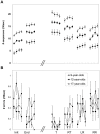Sequence specific motor performance gains after memory consolidation in children and adolescents
- PMID: 22276097
- PMCID: PMC3261869
- DOI: 10.1371/journal.pone.0028673
Sequence specific motor performance gains after memory consolidation in children and adolescents
Abstract
Memory consolidation for a trained sequence of finger opposition movements, in 9- and 12-year-old children, was recently found to be significantly less susceptible to interference by a subsequent training experience, compared to that of 17-year-olds. It was suggested that, in children, the experience of training on any sequence of finger movements may affect the performance of the sequence elements, component movements, rather than the sequence as a unit; the latter has been implicated in the learning of the task by adults. This hypothesis implied a possible childhood advantage in the ability to transfer the gains from a trained to the reversed, untrained, sequence of movements. Here we report the results of transfer tests undertaken to test this proposal in 9-, 12-, and 17-year-olds after training in the finger-to-thumb opposition sequence (FOS) learning task. Our results show that the performance gains in the trained sequence partially transferred from the left, trained hand, to the untrained hand at 48-hours after a single training session in the three age-groups tested. However, there was very little transfer of the gains from the trained to the untrained, reversed, sequence performed by either hand. The results indicate sequence specific post-training gains in FOS performance, as opposed to a general improvement in performance of the individual, component, movements that comprised both the trained and untrained sequences. These results do not support the proposal that the reduced susceptibility to interference, in children before adolescence, reflects a difference in movement syntax representation after training.
Conflict of interest statement
Figures


References
-
- Karni A, Meyer G, Jazzard P, Adams MM, Turner R, et al. Functional MRI evidence for adult motor cortex plasticity during motor skill learning. Nature. 1995;377:155–158. - PubMed
-
- Rozanov S, Keren O, Karni A. The specificity of memory for a highly trained finger movement sequence: Change the ending, change all. Brain Res. 2010;1331:80–87. - PubMed
Publication types
MeSH terms
LinkOut - more resources
Full Text Sources
Medical

